La monetizzazione dei contenuti e la creazione di follower sono tra i miliardi di cose che un marketer di contenuti sogna. Ma cosa succede se i tuoi video non sono così utili per attirare l'attenzione? Incolperesti la tua fortuna o ti impegneresti invece a imparare gli elementi essenziali per la creazione di video?
Se stai cercando di basarti sugli elementi essenziali per la creazione di video, sei nel posto giusto. In questo articolo imparerai come realizzare un video online non solo gratuitamente, ma anche creare video che parlino al tuo pubblico di destinazione come se fosse seduto dall'altra parte della scrivania.
Quindi, iniziamo velocemente.
Come realizzare un video online gratuitamente
La creazione di un video è relativamente facile con Typito e può richiedere solo pochi minuti.
Passaggio 1:registrati e crea un progetto video
- Vai su typito.com e registrati per un account gratuito. Puoi registrarti utilizzando il tuo ID e-mail o Google o Facebook. Scegli ciò che è conveniente per te.
- Una volta effettuata la registrazione, verrai reindirizzato alla home page di Typito. Fai clic su Nuovo progetto .
- Successivamente, vedrai un elenco di formati video. Fai clic sul formato in cui desideri creare il tuo video premendo crea pulsante.
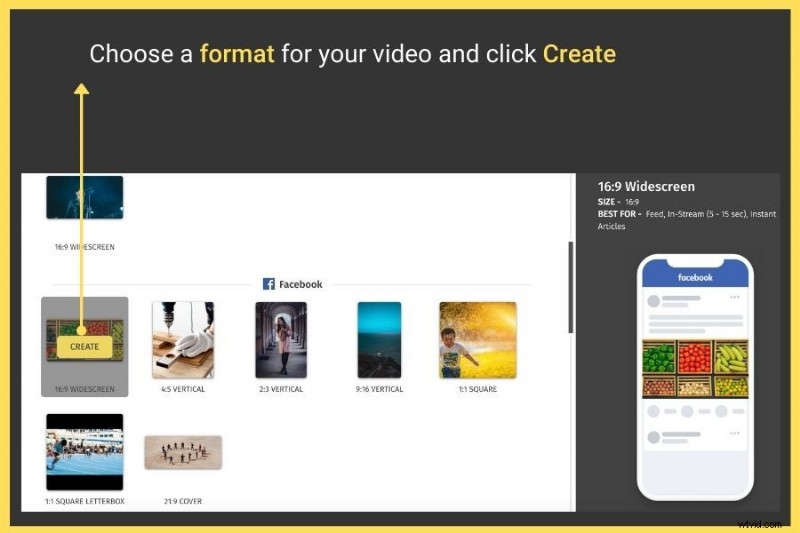
- Se non desideri utilizzare alcun formato predefinito visualizzato e preferisci crearne uno tuo, fai clic sul pulsante Crea formato personalizzato in alto.
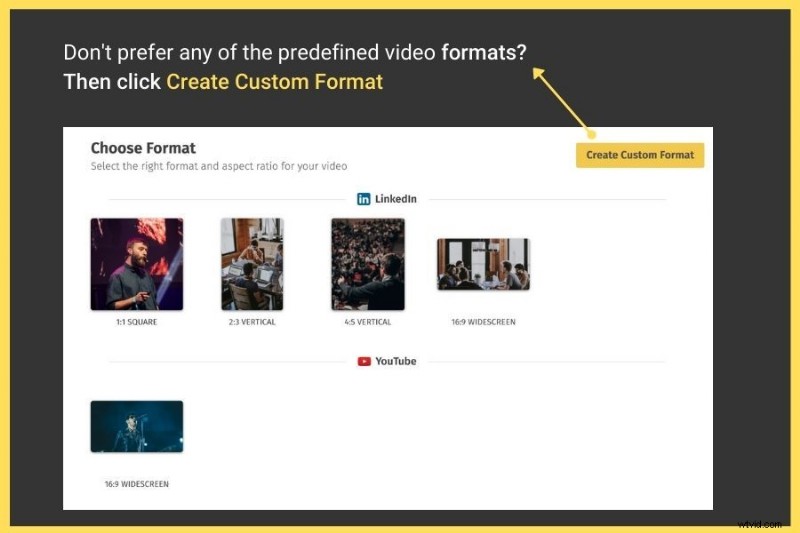
- Vedrai un pop-up in cui puoi inserire il nome, lo scopo, la larghezza e l'altezza (in pixel) del formato video e la spaziatura interna (in %). Dopo aver inserito tutti i dettagli, fai clic su Crea .
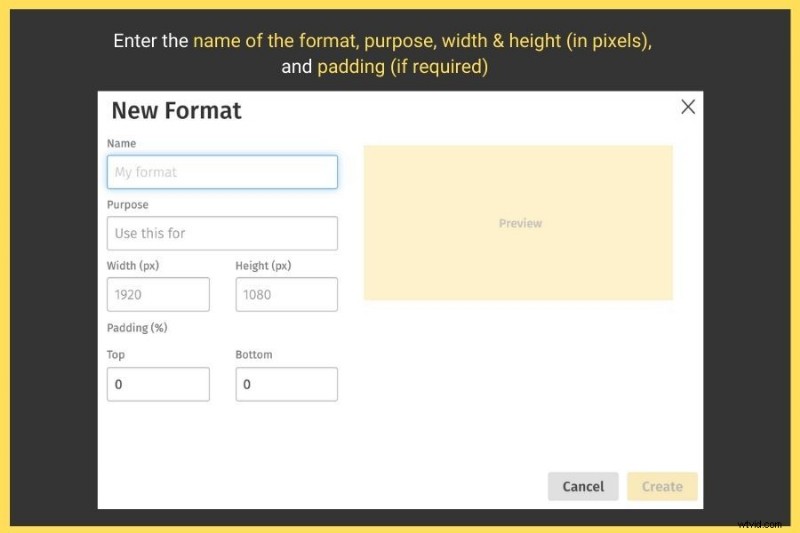
Passaggio 2:Carica il video dal tuo computer o scegli dallo stock libreria multimediale
Indipendentemente dal formato video che scegli (che sia YouTube, Linkedin, Instagram, Twitter, Facebook o Personalizzato), verrai reindirizzato a una pagina che ti offre 2 opzioni per importare un video:
- Carica: Ti consente di caricare un video dal tuo computer
- Archivi multimediali: Ti consente di selezionare un video dalla libreria di filmati stock integrata
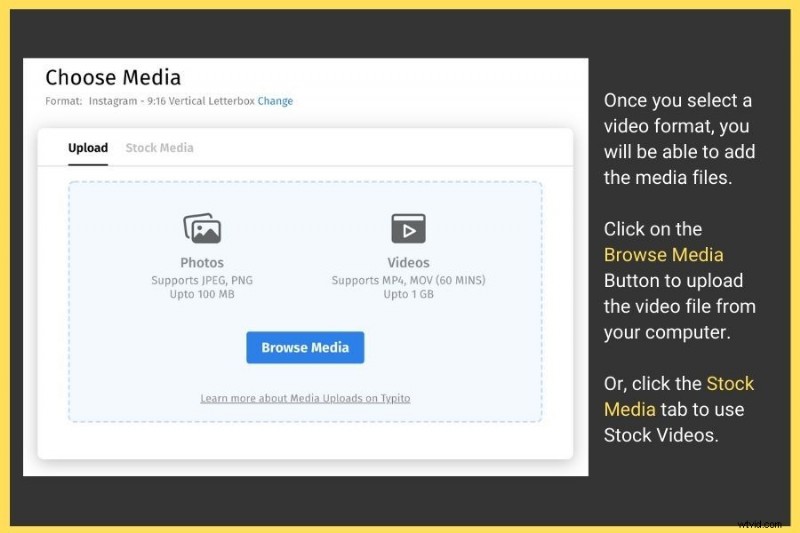
Suggerimento professionale: Puoi fare due cose qui:
- Crea un video utilizzando solo immagini e musica (vedi qui)
- In alternativa, carica il tuo filmato non elaborato che hai girato con la fotocamera e rendilo professionale utilizzando le funzionalità integrate di Typito
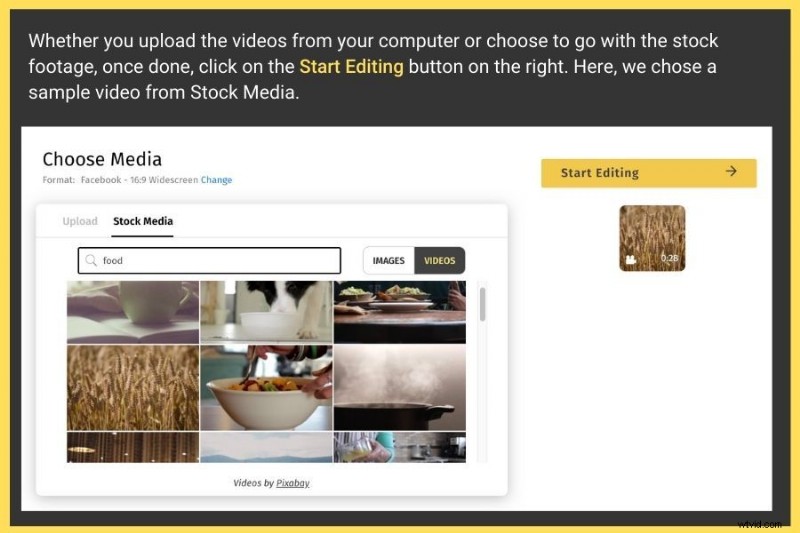
In base alle dimensioni del video caricato, il processo di importazione richiede da pochi secondi a minuti. Al termine, fai clic su Inizia modifica pulsante da destra.
Passaggio 3:modifica il video per dare un tocco professionale
Verrai reindirizzato alla dashboard intuitiva di Typito con il filmato caricato nello stesso formato (o dimensioni) che avevi scelto.
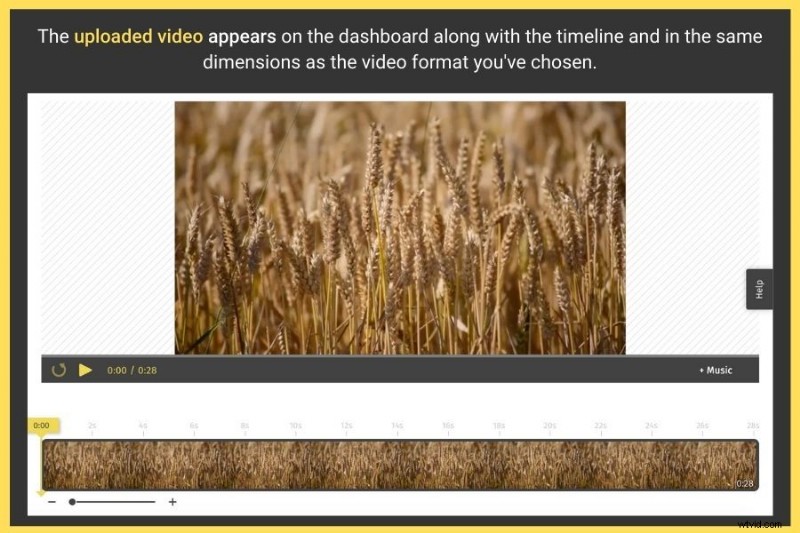
Vedrai 5 schede che ti consentono di aggiungere gli elementi essenziali per creare un video coinvolgente nel pannello di sinistra.
- Testo sul video:titoli, terzi inferiori e invito all'azione
- Sovrapposizioni di immagini
- Aggiungi musica o audio
- Clip video e immagini
- Sottotitoli o didascalie
Ecco un rapido sguardo a ciò che ciascuno di questi elementi può fare per migliorare il tuo video.
1. Aggiunta di testo al tuo video
L'aggiunta di testo al tuo video è abbastanza semplice con questa opzione. Ecco cosa devi fare:
- Dal pannello di sinistra, fai clic su Testo scheda.
- Vedrai una serie di modelli di testo predefiniti tra cui scegliere. Se sei un principiante e probabilmente non sai da dove cominciare, ti consigliamo di scegliere uno di questi modelli di testo stilizzato. Questi includono modelli di testo di base e animati.
- Per applicare il modello di testo al tuo video, fai clic una volta su di esso.
- Una volta che il tuo modello di testo appare nell'area di lavoro del video a destra, puoi abbellirlo ulteriormente modificando lo stile del carattere, il colore, la dimensione, l'allineamento, lo spazio delle lettere, l'altezza della linea, ecc. Oltre a questi, puoi anche aggiungere l'animazione effetti al testo.
La funzione "testo" include anche alcune altre sottocategorie come:
- Titoli : L'apertura del tuo video con un titolo di testo in grassetto grande assicura un'ottima prima impressione per il tuo video. Scegli un modello adatto al tuo video dalla raccolta di modelli di titoli.
- Social media : L'aggiunta di CTA sui social media è un ottimo modo per mostrare la presenza del tuo marchio su più piattaforme. Puoi aggiungere inviti all'azione affinché gli spettatori ti seguano, a seconda delle piattaforme di social media su cui sei più attivo.
- Terzi inferiori : Prendi in considerazione l'aggiunta di sottotitoli di testo posizionati nella metà inferiore del tuo video per coinvolgere gli utenti che guardano il tuo video senza audio. Puoi scegliere tra i vari modelli di testo animato per dare al tuo video un tocco stilizzato più professionale.
- Con marchio : Se hai un logo per il tuo marchio o caratteri particolari associati al tuo marchio, questo è qualcosa che dovresti assolutamente usare nel tuo video. Ciascuno dei modelli con marchio ti consente di aggiungere facilmente un logo ai titoli dei tuoi video.
Basta fare clic una volta su uno di questi modelli di testo per aggiungerlo all'area di lavoro video sulla destra. Puoi quindi trascinarlo e posizionarlo dove vuoi.
2. Aggiunta di un'immagine al tuo video
Potrebbero esserci momenti in cui potresti dover aggiungere alcune immagini, forme o icone nel mezzo della clip per più contesto o semplicemente sovrapporre un'immagine del tuo logo al tuo video.
Ecco come aggiungere facilmente una sovrapposizione di immagini, forme o icone al tuo video:
- Dal pannello di sinistra, fai clic su Immagini scheda.
- Ora vedrai 3 opzioni:Forme, Icone, e I miei caricamenti .
- Forme e icone: Include una serie di forme geometriche predefinite che puoi utilizzare nel tuo video.
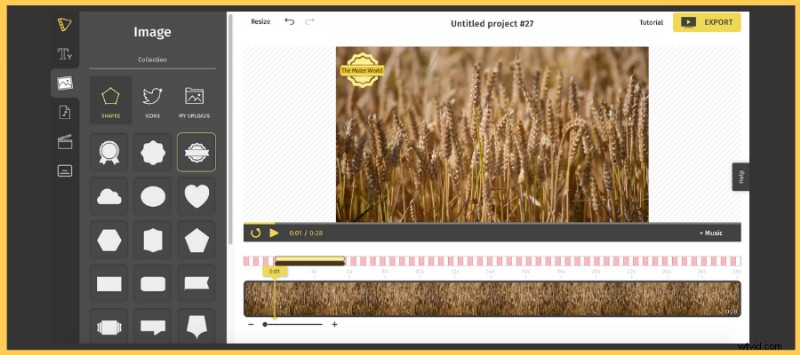
- I miei caricamenti: Ciò ti consente di caricare i tuoi loghi o icone che desideri utilizzare nel tuo video.
Fai clic una volta su un modello per aggiungerlo al tuo video sulla destra.
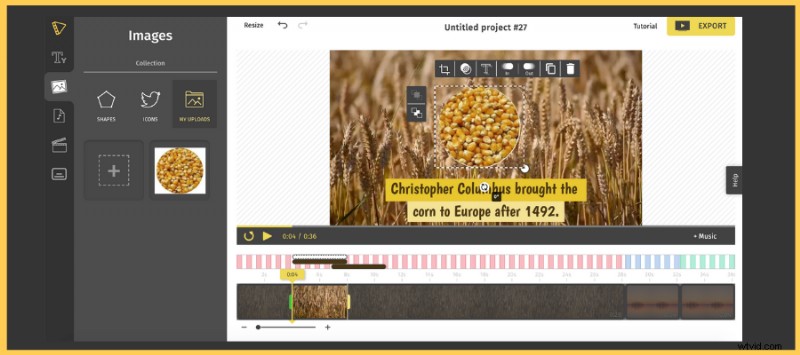
La musica gioca un ruolo chiave nell'aumentare il coinvolgimento per i tuoi video. Ciò è particolarmente vero se stai creando un video senza testo, didascalie o elementi visivi accattivanti.
3. Aggiunta di audio al tuo video
Dalla creazione di una buona introduzione, all'aggiunta di tracce in base all'umore o alla regolazione del volume della musica di sottofondo, puoi fare tutto questo con un solo clic.
Ecco come puoi aggiungere l'audio al tuo video:
- Dal pannello di sinistra, fai clic su Audio scheda.
- Vedrai due opzioni:Libreria e Caricamenti .
- Libreria :la libreria audio contiene oltre 150 tracce royalty-free che puoi aggiungere al tuo video. Puoi sfogliare più generi/categorie come:cibo, fitness, aziendale, avventura e altro ancora, per scegliere una traccia musicale per trovare la musica adatta per il tuo video.
- Passa il mouse su una traccia, fai clic sul pulsante di riproduzione per ascoltare l'anteprima e, se ti piace quello che ascolti, fai clic su +Aggiungi pulsante per aggiungerlo al tuo video.
- Carica :Se desideri caricare la tua traccia, fai semplicemente clic sul pulsante Carica e scegli il file audio dal tuo computer.
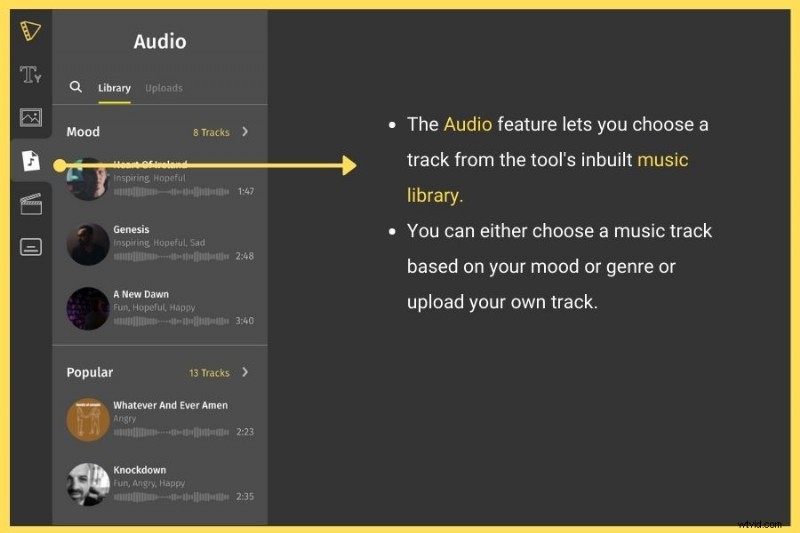
- Indipendentemente da come aggiungi la musica, nel momento in cui la applichi, visualizzerai immediatamente un popup con un'opzione per tagliare l'audio con l'aiuto di un cursore trascinabile. Ciò ti consente di utilizzare una parte specifica dell'audio per il video.
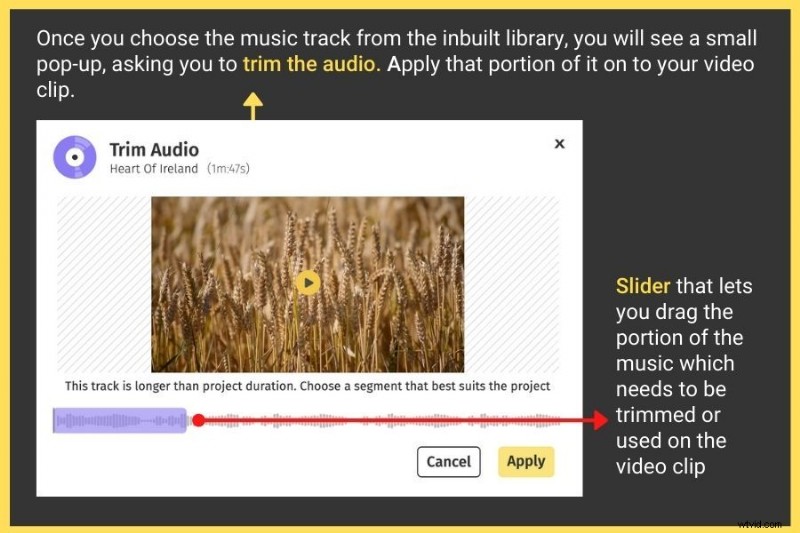
- Dopo aver aggiunto la musica al video, hai la possibilità di modificare il volume sia dello sfondo che della musica in qualsiasi momento.
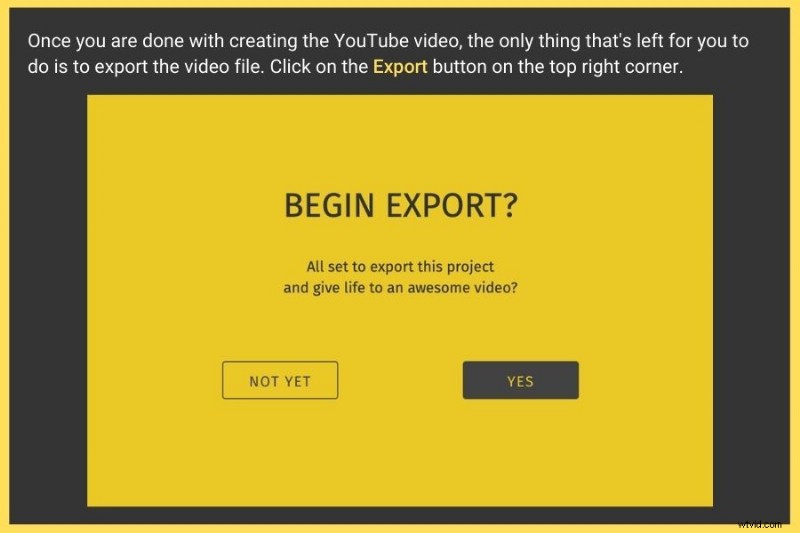
5. Aggiunta di immagini al tuo video
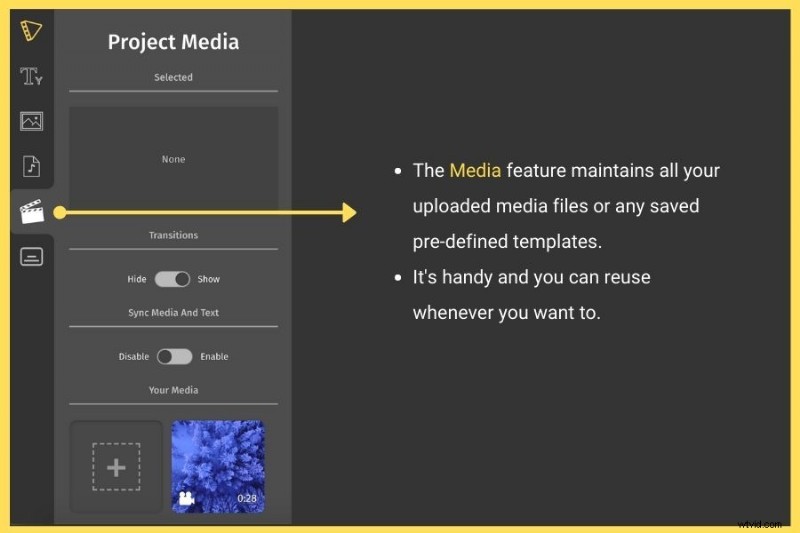
I Media ti consente di caricare immagini o più clip video e unirli insieme per creare un video, come una presentazione o clip di immagini con alcuni effetti di transizione o compilation video.
6. Aggiunta di sottotitoli al tuo video
I sottotitoli sono un ottimo modo per rendere i tuoi video più accessibili e coinvolgenti. It allows hard-of-hearing and d/Deaf individuals to not just watch and enjoy your video content but also ensures that they remember the information more easily. More than that, it’s also great for people who prefer watching videos in sound-sensitive environments.
With Typito, adding captions is easy and straightforward. Here’s what you need to do:
- From the left panel, click on the Captions icon.
- You will see a wide array of basic and stylized text templates.
- Choose any one of the text templates that you like to add to your video and click once.
- This gives a preview of the way it looks on the video.
- You will also see something called Position , which is basically an option to align the captions to top, middle, or bottom .
- Once you’ve aligned the captions, the next step is to click the “Next, add content ” button.
- You will then be prompted to add the content for your captions.
Step 4:Export the video and download
After you have played around with all the features and perfected your video, you just have to download it. To do this, follow these steps:
- From the top right corner, click on the Export button.

- Your video begins to export. This takes from a few seconds to minutes, based on your video size.
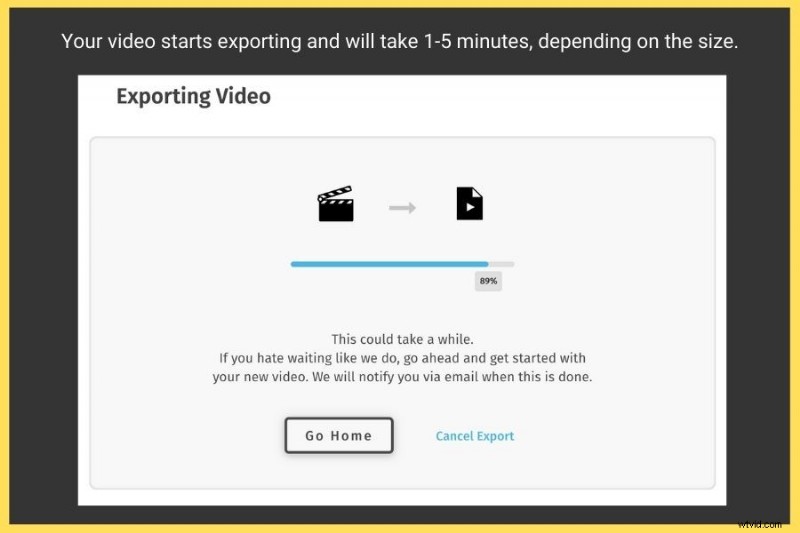
- Once that’s complete, your created video is ready to be:
- Downloaded in HD format and saved to your local drive
- Published to your YouTube channel directly
- Shared on Facebook
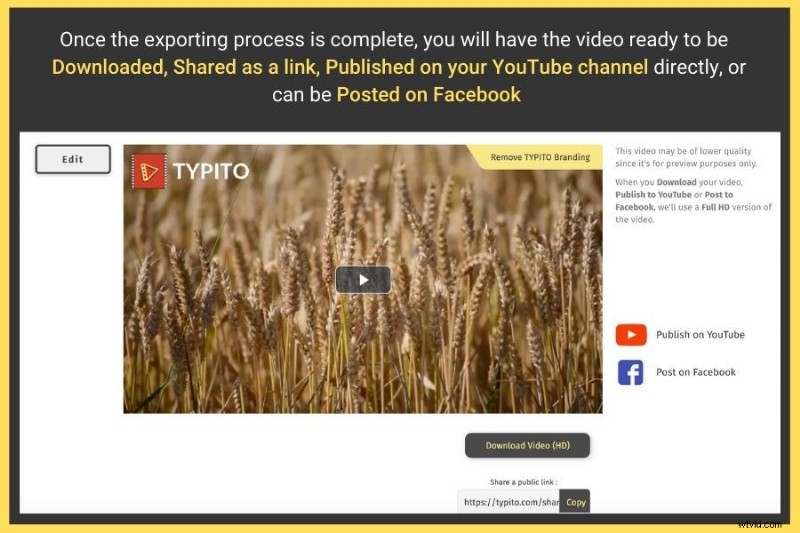
Now that you have learned how to make a video online for free, learn a few more essential video-making tips before you start making one.
Tips to Keep in Mind While Making a Video
If you’re nervous about making your first video, you aren’t alone. Most aspiring vloggers and videographers face the same hurdle after starting a YouTube channel or video project. Most of them can’t seem to understand how to make riveting video content with a modern vibe.
If you’re among the aspiring stars and cinematographers, here’s a chance you wouldn’t want to miss because in this blog you’ll learn the tips to keep in mind while making a video. So stick around till the end as we walk through the essentials that you’ll need even before getting started.
A lot of preparation goes into pre-production to get each shot right so that you don’t have to take the same path twice. My approach in this blog is to break down the process into smaller bits so that you can pause and practice each technique as you scroll.
Not to sound preachy, but you don’t have to spend a whole lot of money to become a professional video maker. At least, your first video needn’t be shot on a high-end camera, even a mobile phone makes a great tool to get the video professionally shot and edited with an easy-to use video editing tool like Typito.
Legends Make Videos and Not Clickbait
Congratulations on taking baby steps to launch your video project. The next stage is getting smaller things sorted. That includes brushing basics and keeping tools handy to start and finish the project within a stipulated time.
So without ado, let’s begin with tips that nobody talks about.
1. Light Brings Videos to Life
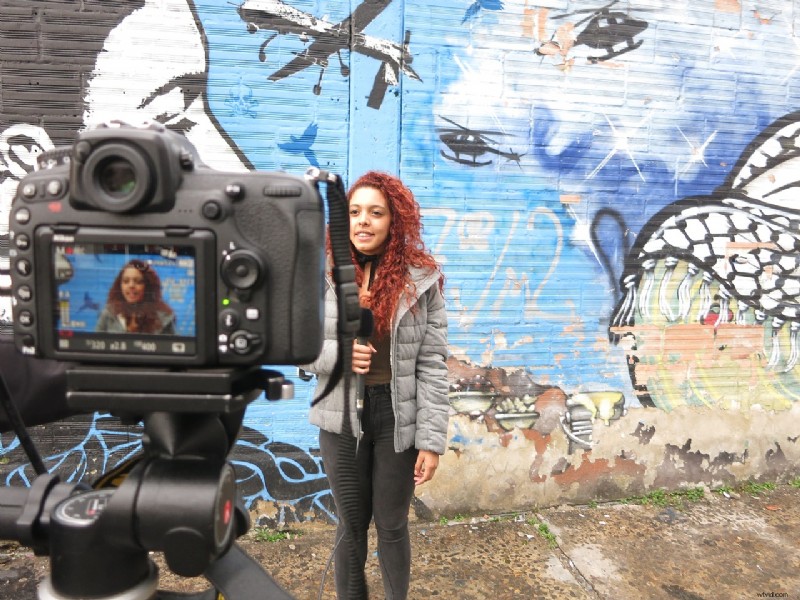
In cinematography, light shapes mood. It adds production value and makes the video richer and expressive. A soft light hitting the face brings the focus onto an object or character in your video while a bright dispersed light is more straightforward and general.
A misplaced light source clashes with the quality of the production and makes the video seem budget-strained. Natural light is strangely appealing in videos so shooting during the early hours and evening adds drama to scene composition.
At all costs, avoid shooting in piercing bright midday light to avoid dealing with unflattering shadows. It’s every video editor’s nightmare. While shooting indoors, experiment with symmetrical lights to illuminate the face and add intensity to the scene.
If you’re shooting marketing videos always leave the face well-lit for a positive vibe. If you’re taking the pro steps, it’s worth trying the lighting triangle to let the light flow around the features of your subject to create a pleasing composition.
2. Use Background to Compose Scenes

The background in a video is just as important as the foreground. If you are planning to compose a professional shot, choose the background wisely, and remove all distractions from the scene. Use a solid backdrop like heavy drapes and decorative paper to fill the void.
The most important thing is to make sure to place actors away from the backdrop to avoid inadvertent shadow casts. If you can’t make do with props available at home, rent a studio to use as a filming set.
When shooting at unfamiliar sets, be aware of reflective surfaces and window panes that reflect equipment or behind the scene crew. Moreover, placing actors near windows where outdoor light enters can cause unnecessary silhouettes.
3. Pick a Video Editor to Improve Quality

So you’ve got the production completed, what’s next? Raw footage is not a presentable material on its own. It must go through post-production where editors transform the footage by adding flavors like SFX, VFX, and also editing away unnecessary bits to arrive at a final version.
Even if you’re a beginner, make sure to use simple editing tools to make your footage appealing. These can take your video processing to whole new heights.
Some of the simpler features that you can exploit from free editing tools are text inclusion, cropping, scene transitions, and modifying aspect ratios. Some mid-tier versions also support filters, overlays, as well as stock audio and video.
4. Don’t Overdo the Edits

When you try the editor for the first time, be prepared to feel overwhelmed by its features. Only pick effects that increase the production quality and discard the rest.
In most scenarios, your footage may not need one or any effect at all. It’s always better to avoid going overboard with edits.
However, a few things are mandatory - Like using noise cancellation to remove background noise, adjusting brightness, cutting unwanted pauses, adding cool transitions, and BGM.
5. Use Audio to Make an Impact

Have you ever had to click a YouTube video and then immediately close it because of bad audio? It’s wired into humans to reject unappealing content, especially the audio.
Most people are patient enough to watch videos that may not be HD or if videos appear slightly grainy. But distorted audio is enough to make them pay no heed. So before making your first video, make sure you have set aside a small budget for an external microphone.
If you aren’t short-strapped, it won’t hurt to spend a little more on an HD microphone. After recording the audio from an outdoor location, edit away distractions like birds, wind noise, and traffic to call the viewer’s attention to a particular activity.
6. Use Image Stabilization

One important thing to remember in video-making is to record visuals without making viewers feel dizzy or seasick. Unless it’s part of the script, jerky videos will have people cursing you for not using a stable platform.
If you have shaky hands or aren’t set up to shoot hand-held, it’s best to set down the camera on an immovable surface (or use a gimbal or tripod if you have money to spare). Your skill will be put through paces when panning the camera. The smoother you do it, the more professional it seems.
However, if you can’t pan without ruining the production quality, consider changing perspective by cutting shots and making transitions.
If you still have shaky scenes in your master footage, use a video editing tool with image stabilization to fix the flaw. It’s mostly a one-click operation so it isn’t an exhausting effort. Alternatively, you could shoot using a video camera with built-in image stabilization.
7. Use Rule of Thirds to Compose Shots
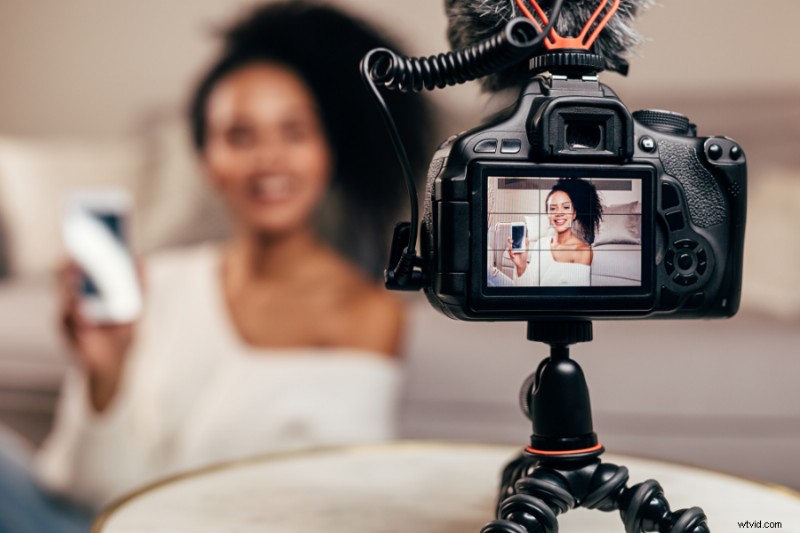
If you insist on taking a professional approach, go with the rule of thirds to achieve pleasing footage.
According to this technique, the subject is placed along with the intersecting points on the grid lines. That is where the camera sensor captures the best details. It also adds a cinematic effect to the shot than having the subject stand in the dead center.
However, the rule of thirds isn’t always a textbook approach. It’s only a creative step to achieve unconventional results. If you’re a budding video maker, this is one of many important skills that’ll come in handy when regular shots start to seem unsuited.
8. Your Phone is a Great Video Making Tool

Thanks to Apple and its iPhone series, mobile photography exploded into a fad that people still follow. It’s a new genre where you don’t even have to own a DSLR to capture visuals. Instead, professional shots are conceived using just a mobile phone.
With manufacturers cramming more megapixels they can to phone sensors, it’s gotten better for end-users. Although not a replacement for pro SLRs, it does unarguably well compared to entry-level and mid-range SLRs. But be mindful of caveats if you’re going with mobile videography.
Shoot using the main camera because that’s where the sensor is bigger. Most selfie cameras on high-end mobile phones don’t fare as much as the main rear camera.
Shoot in the landscape to achieve the 35mm effect. It captures more details that improve video production quality on a larger screen. If possible use the overlay grid to maintain the level.
9. Create a Production Plan Before the Shoot

Above everything else, it’s important to meticulously prepare a plan beforehand to avoid last-minute changes. Impromptu shoots are great for a family occasion where moments weigh more than precision.
But if you’re stepping into the world of professional cinematography or if you want to make a career out of film-making, the complete schedule must be well-coordinated to avoid expenses from adding up due to disruptions.
Plan your production in stages and make sure to note progress, meeting deadlines, and time management. If you need a leg up in setting a basic production timeline, here’s what you need.
Start with production goals. Prepare questions like what you want to convey through your script and who will watch it and how your video will speak to viewers.
Whether shots will seem like a first-person/third-person perspective or a different one that isn’t tried before matters in production. You’ll be confronted with more questions as you get started and build momentum.
Once your goals are set, begin with scriptwriting and storyboarding. Most first-time video makers rush scriptwriting and stop abruptly when they’ve wandered off from the focus. It’s a learning experience, so don’t hesitate to revise portions till you’re satisfied with the way your script sounds when read out loud.
Here, being concise is the key to keep the audience riveted. Don’t prolong narrative portions unless it has any production value.
With the attention span of a goldfish, most content consumers would want excitement when the button is punched. They tend to become impatient when the plot slows down before getting to the interesting bits.
Conclusion
If making a video has been your life-long passion, get started now and use these tips to sharpen individual bits of production to make you make your video praise-worthy. I am sure, doing so will help you become a great filmmaker in the days ahead.
Most newbie filmmakers go through a vicious cycle of reworking their approach till it’s polished to perfection. Don’t forget to emulate the methods of rule-breakers because there is no single right path in video-making.
Modern video makers are constantly exploiting props and stage elements in bizarre ways to make shots shimmer. They do so, by deliberately deviating from traditions to get their work nominated for outstanding elements.
Someday, you could become an innovative filmmaker with a signature style that your movies will be associated with. So work persistently, and learn from mistakes to perfect your shots.
